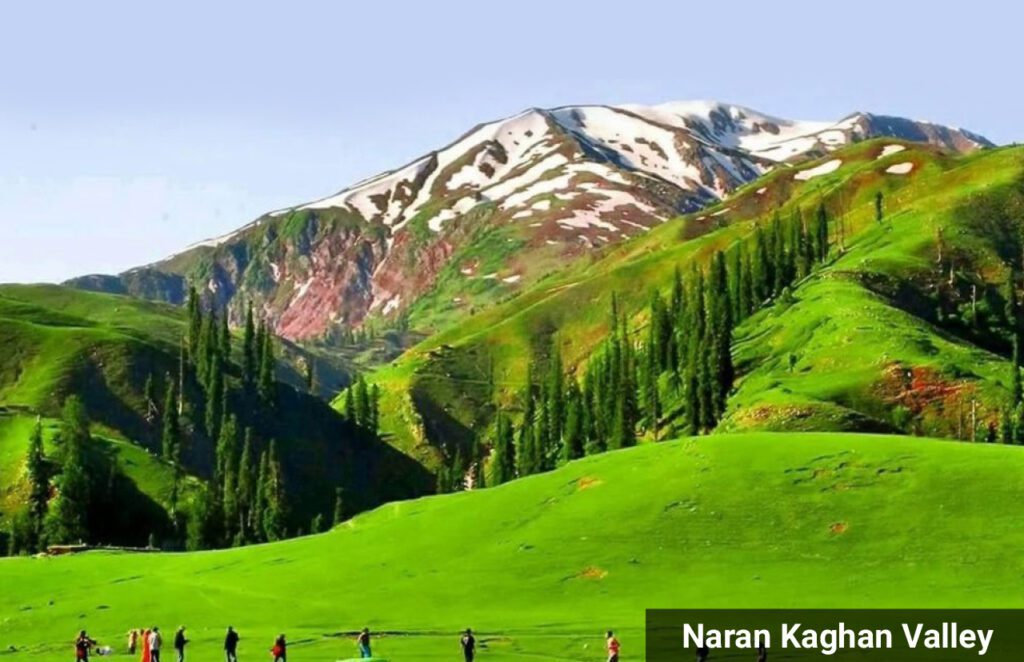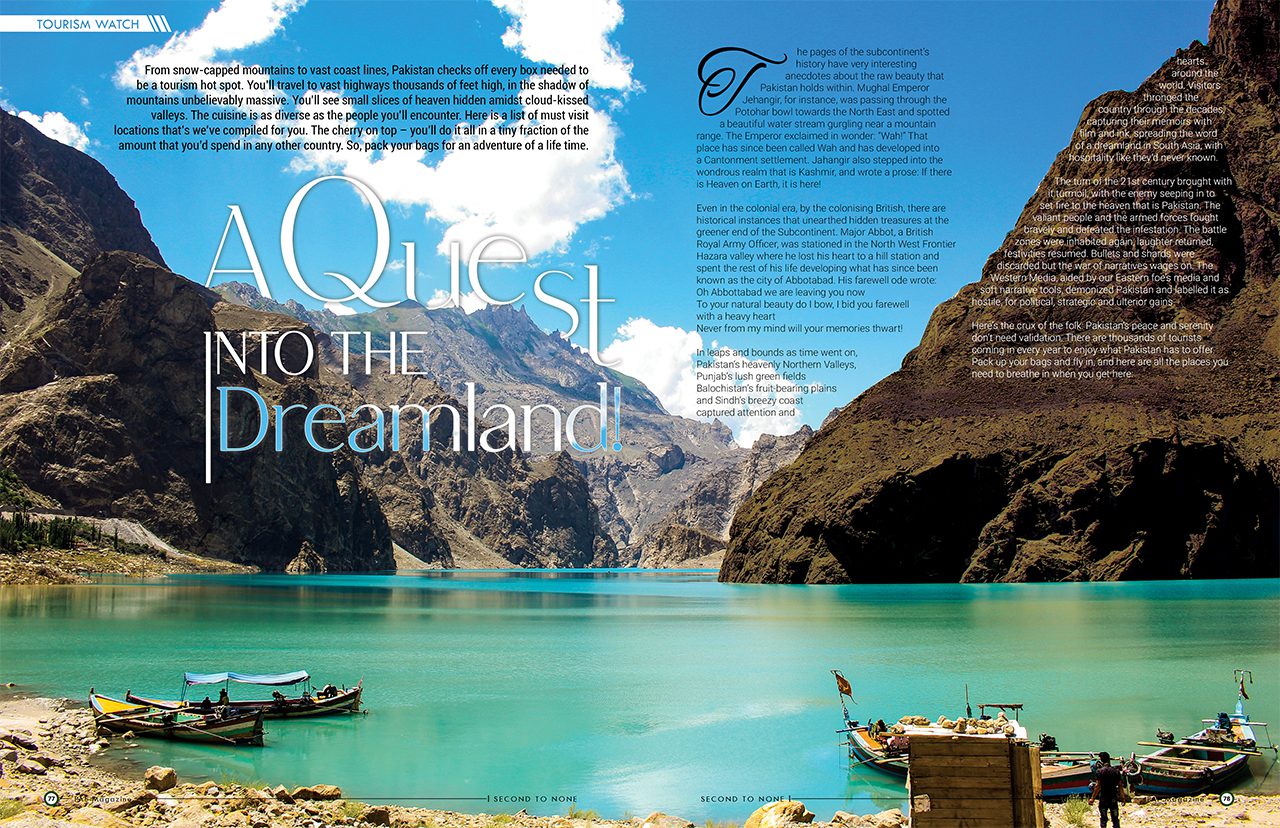From snow-capped mountains to vast coast lines, Pakistan checks off every box needed to be a tourism hot spot. You’ll travel to vast highways thousands of feet high, in the shadow of mountains unbelievably massive. You’ll see small slices of heaven hidden amidst cloud-kissed valleys. The cuisine is as diverse as the people you’ll encounter. Here is a list of must visit locations that’s we’ve compiled for you. The cherry on top – you’ll do it all in a tiny fraction of the amount that you’d spend in any other country. So, pack your bags for an adventure of a life time.
The pages of the subcontinent’s history have very interesting anecdotes about the raw beauty that Pakistan holds within. Mughal Emperor Jehangir, for instance, was passing through the Potohar bowl towards the North East and spotted a beautiful water stream gurgling near a mountain range. The Emperor exclaimed in wonder: “Wah!” That place has since been called Wah and has developed into a Cantonment settlement. Jahangir also stepped into the wondrous realm that is Kashmir, and wrote a prose: If there is Heaven on Earth, it is here!
Even in the colonial era, by the colonising British, there are historical instances that unearthed hidden treasures at the greener end of the Subcontinent. Major Abbot, a British Royal Army Officer, was stationed in the North West Frontier Hazara valley where he lost his heart to a hill station and spent the rest of his life developing what has since been known as the city of Abbottabad. His farewell ode wrote: Oh Abbottabad we are leaving you now To your natural beauty do I bow, I bid you farewell with a heavy heart Never from my mind will your memories thwart!
In leaps and bounds as time went on, Pakistan’s heavenly Northern Valleys, Punjab’s lush green fields Balochistan’s fruit-bearing plains and Sindh’s breezy coast captured attention and hearts around the world. Visitors thronged the country through the decades, capturing their memoirs with film and ink, spreading the word of a dreamland in South Asia, with hospitality like they’d never known.
The turn of the 21st century brought with it turmoil, with the enemy seeping in to set fire to the heaven that is Pakistan. The valiant people and the armed forces fought bravely and defeated the infestation. The battle zones were inhabited again, laughter returned, festivities resumed. Bullets and shards were discarded but the war of narratives wages on. The Western Media, aided by our Eastern foe’s media and soft narrative tools, demonized Pakistan and labelled it as hostile, for political, strategic and ulterior gains.
Here’s the crux of the folk: Pakistan’s peace and serenity don’t need validation. There are thousands of tourists coming in every year to enjoy what Pakistan has to offer. Pack up your bags and fly in, and here are all the places you need to breathe in when you get here:
Naltar Valley
Since mid-2019, Naltar has become a hot spot for tourist activities, garnering attention for its unparalleled scenery. Your journey to Naltar will begin with leaving the Karakorum Highway by Gilgit. The track is a little bumpy and adds to the travel time. It will take you almost a 2-hour jeep ride to get up there. Please avoid taking cars (your own or rental); that’s neither safe nor viable. Plus, you will miss out on the ‘jeep-thrills’! You might think the two-hour ride is too long and tiring but, it is worth every single.
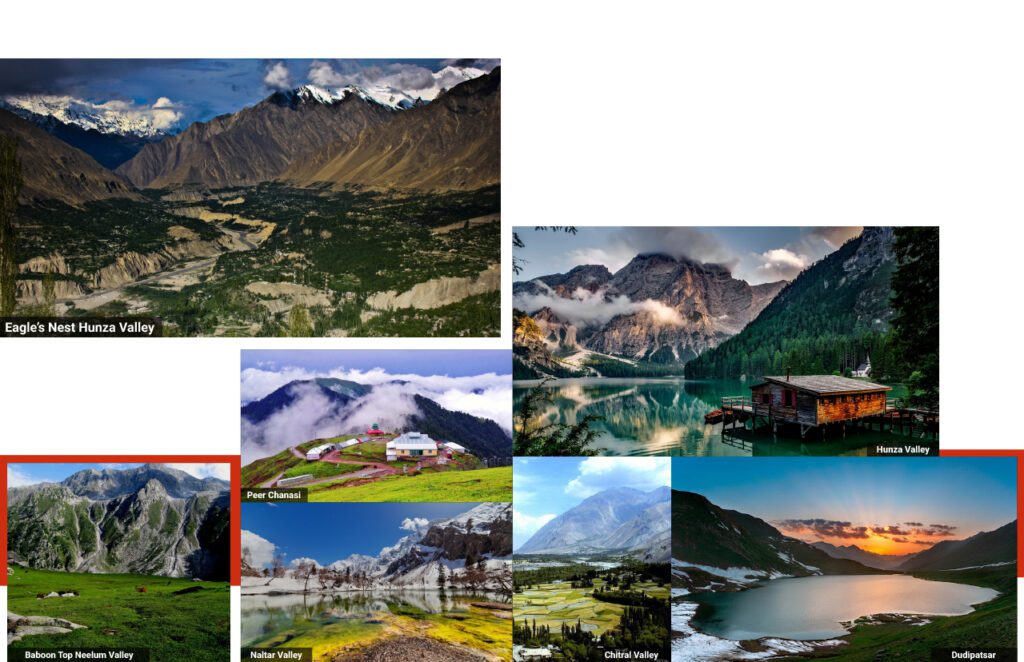
What’s Naltar like? Well, imagine a land with air so crisp, grass so green and skies so blue, they look right out of a fairytale! The valley is surrounded by clear lakes and dense forests. The three lakes are collectively known as Bashkiri Lakes.
The path that leads to the lakes is covered with abundant green plains. On the way, you will find herds grazing on the grassland. Stop and take a picture holding a baby goat, because why not? This place is filled with social media worthy nature. The first of the three lakes is Satrangi of 7 colours. The second is Lakepari, and the third is Lake Firoza. The splendour of Satrangi Lake is beyond words, especially if you haven’t visited any lakes before. Also, the name Satrangi is quite meaningful. The still waters of the lake reflect a colourful palette painting a vibrant canvas of its own!
Lakepari is bigger than Satrangi and provides boat service as one of the many fun options available to visitors. There’s also a campsite along the lake site.
To visit Lake Firoza, you would have to set out on foot. No paved road leads you to it, and no vehicle would help. The only option is trekking all the way up to the lake. The 45 minute-walk would pass like a breeze. The 360-degree view of snowcapped mountains will offer all the distraction that you need.
While trekking, you might want to pause after every few steps. Breathe deeply as the air gets colder the higher you climb. Once you reach Firoza Lake, the beautiful landscape surrounding it will take your breath away.
Sit on the top of the mountain slope and watch the tranquil lake. Being in nature and away from the concrete jungle allows your mind to wander. Who knows, on this journey you might even discover yourself all over again!
Muzaffarabad
Azad Kashmir requires no lengthy descriptions; its beauty speaks for itself. It is the city of panoramic landscapes with a bonus – the exquisite Kashmiri Cuisine.
With so much that Kashmir has to offer, Neelum Valley deserves a special mention. Neelum Valley stretches out from the north of Muzaffarabad (the capital of Azad Kashmir), from the Chela Bandi Bridge to Tau Butt. It expands over 240 kilometres.
One of the most beautiful valleys of Azad Kashmir, Muzaffarabad boasts freshwater streams, brooks, a river, and snowy mountains. ‘Neelum Valley’ is literally translated as the ‘Blue Gem Valley’ and the name pretty much sums it all. The flowing waters of the Neelum Valley run along the roads until they finally merge with Baboon Valley.
Baboon Valley
Tops the charts as of the most popular tourist destinations. How to get there? It takes around 4 hours to reach Muzaffarabad from Islamabad, which is basically a gateway to Azad Kashmir. From Muzaffarabad, you proceed to Kutton, Khillun, and finally, you reach Baboon Valley. The highlight of Baboon Valley is the thicket of tall trees reaching out towards clear blue skies. You will get to see grazing cattle in the backdrop of snowy white patches. Take in the ambience, stroll in the meadows, and experience the time of your life. Baboon is one of those places where you can sit with your thoughts and practice mindfulness. It is beautiful as well as peaceful. If you are lucky enough, you may even come across a few horses running through the plains. It’s like a scene straight out of an adventure flick.
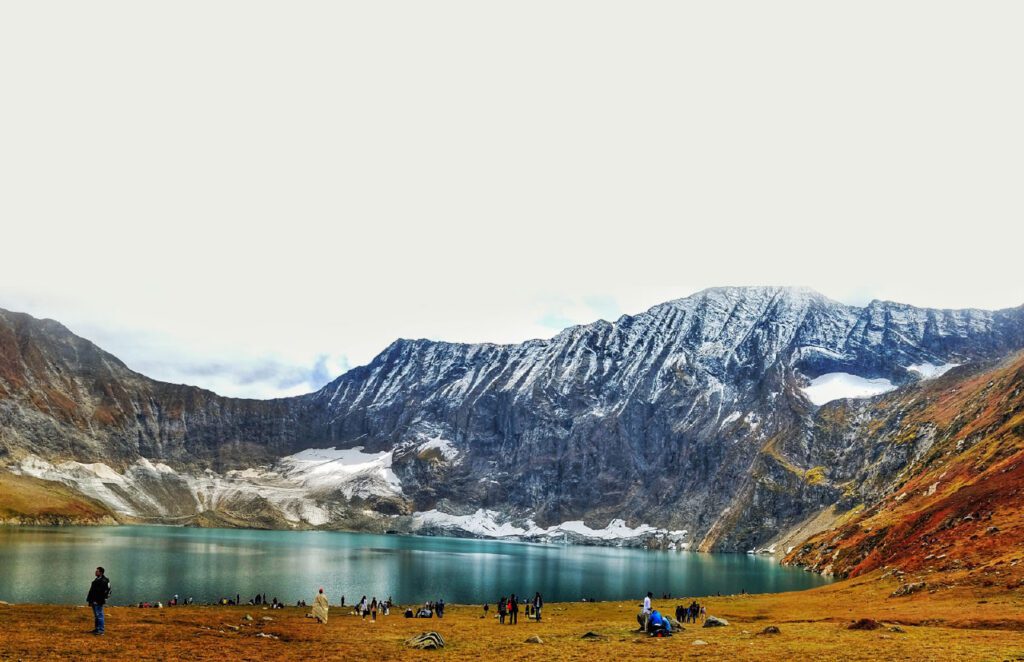
Due to a surge in popularity of these tourism spots, locals have innovated what we can call a ‘Desi – Air BnB’. Many residents have started to host tourists in their houses. They charge some amount, depending on the number of people and the duration of stay.
Any discussion of Kashmir is incomplete without raving about its scrumptious cuisine. If you travel all the way to the country’s north, don’t hesitate to try out the traditional tastes of the town. Don’t go looking for options easily available everywhere. For a truly immersive trip, treat yourself to the culture’s unique flavours. You might not find a crispy chicken burger on the mountaintop, but you won’t eat a better roast in your life!
The mouthwatering aroma of Kashmiri cuisine complements its taste. Some of the delectable food includes Goshtaba, Wazwan (a multi-course meal), Kashmiri Kulcha and the famous Tea.
Goshtaba is a complex dish in terms of its flavour, but it’s easy to make and consume. It consists of a mix of different spices not known to the general public, and it is prepared over long hours. Another souvenir of this magical land is its famous Namkeen Tea, made from dried up tea leaves, almond, salt and other ingredients. Kashmiri Kulcha is available throughout Muzaffarabad as a bakery item.
Dudipatsar
Dudipatsar is next on our list of the most stunning attractions of Pakistan. Sitting in Kaghan Valley, Khyber Pakhtunkhwa, Dudipatsar Lake circles the Lulusar Natural Park. The park and lake are both accessible only during specific periods from June to September. To get to the lake, you may need a jeep again. An ordinary vehicle might not be able to deal with the upper tracks.
Let’s decode the name. ‘Dudi’ translates to milky, ‘Pat’ means Mountains and ‘Sar’ is a lake in the local language. You will absorb much more than the sights when you travel. You will learn a thing or two about the rich dialects and cultures concealed in the far-off areas of Pakistan.
To witness the full charm of Dudipatsar, I would advise you to visit it in July. The landscape with its azure lake, snowcapped mountain peaks and cold crisp air is like a calendar portrait. If you thought Lake Saif-ul-Mulook is the most beautiful, wait till you visit Dudipatsar. You’ll find that it gives Saif-ul-Mulook a run for its money!
For safari enthusiasts, the park consists of exotic breeds of animals rarely found in the world. This includes the marmot, lynx, snow leopards, black bear and more. Wetlands and wildlife are vital for maintaining the ecosystem. Plus, they make for matchless sights on offer for committed adventurers!
Hunza Valley
Pick any piece of writing about Pakistan’s magnetic natural vistas, and you will find Hunza securely placed on all the lists. But don’t be confused by the word ‘valley’ as Hunza is a vast district consisting of several valleys and small villages.
Let’s walk through some of the most breathtaking sites of Hunza:
Passu Cones Passu Cathedral is one of the most recognized – and if I may say, iconic – tourist destinations of Pakistan. Why am I singing its praises? You’ll have to see it to believe it! I cannot recommend it highly enough because in Passu, you’ll find nature at its most incredible.
Though tourists are no longer allowed to stay overnight in Passu Village, you can enjoy the splendid view from Karakoram Highway (about an hour’s drive away from Gilgit). Even if from a distance, the cones are still beautiful to look at and admire!
Eagle’s Nest Visit Eagle’s Nest to experience the most spectacular sunset of your life – No exaggeration! Another notable mention is Lake Attabad – a place where you can glimpse Mother Nature’s unlimited bounties.
Karimabad Karimabad is regularly listed amongst the top 5 tourist attractions of Pakistan, and you’ll be bound to agree. You can travel there by bus, but it will drop you outside the city – why? Well, as a preventive measure to protect the city from pollution.
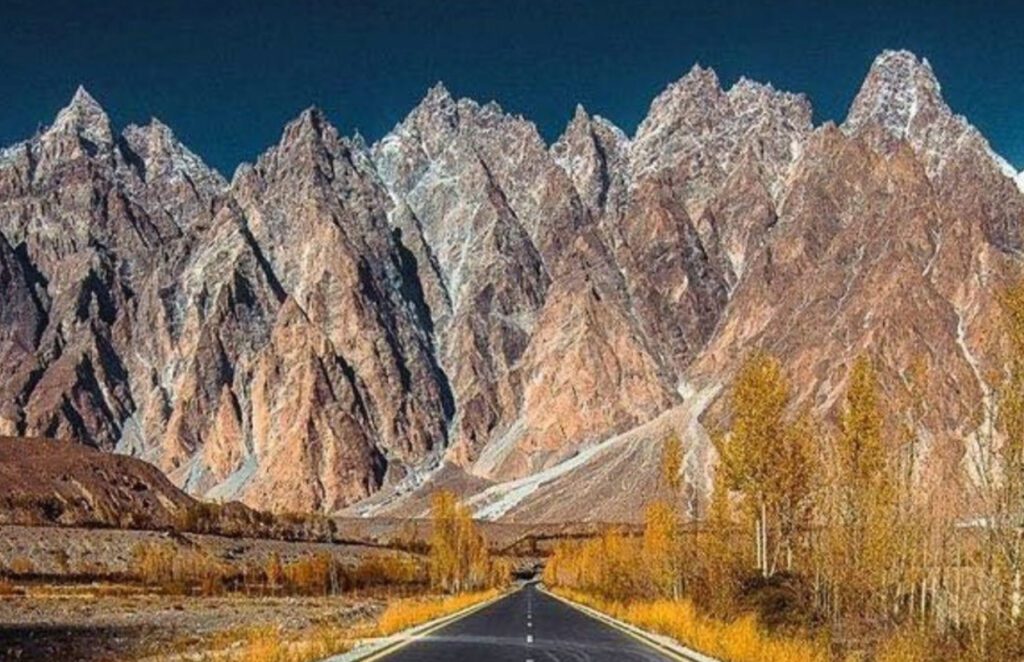
The central valley is surrounded by mountains and is divided into several levels. It hosts some of the biggest and most famous peaks such as Ghenta Peak (7090 m) and Rakaposhi (7788 m).
The town offers a wide range of facilities, from checking into your hotel to a car rental to food and every other service for your comfort. Hotels are readily available so you won’t have any difficulty finding one according to your budget. After checking into your hotel, you can set out and look around this magnificent place. The valley is surrounded by houses, some of which date back to thousands of years. As you view the historical sites, you will feel like you’ve stepped back in time. Apricots are the staple in this region. You will find different delicacies made of apricot every 100 steps. This place is a unique tourist attraction all around the year, especially during summers. The valley boasts dense orchards of apples, apricots and walnuts. It is a beautiful smorgasbord of tradition, nature, culture and civilization.
One of the recent developments of this place is the newly built Luxus Luxury Hunza Hotel. If you can stretch your budget a little, you’ll find this hotel to rival those Instagram honeymoon destinations you’ve probably drooled over.
Paye is emerging as a high-tourist-influx spot, retaining its strong attraction as a green plateau on the top of the Hindukush. The several activities it offers include horse-riding, wandering in the blooming flower fields, or just enjoying the clouds and fog. In Paye, many travellers are enticed to rendezvous with nature.
Coming down, you will have to stay in Islamabad, reputed as one of the top three most beautiful capital cities in the world. The rainforests of the Margala Hills provide a perfect hiking trail. You can admire the city’s elegance from the vantage of Daman-e-Koh. The city has endless green stretches and mini-forests, sure to impress even the most diehard nature-lovers. Describing the charms of Islamabad will take up another article altogether!
This is what a renowned international luxury and lifestyle travel magazine, Conde Nast Traveller, has to say about tourism spots in Pakistan:
“This remarkable country is finally getting the focus it deserves. Because this is a place of exquisite landscapes, where green spaces are overlooked by towering mountains. In fact, Pakistan has more peaks taller than 22,965 feet than China and Nepal combined, making it an almost magnetic spot for adventure travelers and intrepid hikers.”
Pakistan is an excellent place for tourism, as it offers an array of awe-inspiring natural views. Snowcapped mountains, rainforests, plateaus or deserts – take your pick – every attraction delivers an unforgettable experience. Due to its rising popularity, Pakistan Tourism Development Corporation (PTDC) has set up three restaurants and 27 new motels for the convenience of foreign tourists.
In addition, Pakistan was declared the world’s third-highest potential adventure destination for 2020 by the British Backpackers Society. All the news and media headlines highlighting Pakistan’s topographic features only reinforce what locals have known all along about the country’s under-explored wonders.
Pakistan has also grabbed the attention of many international tourists since the past couple of years. We can expect more attention in the years to come as the infrastructure develops.
